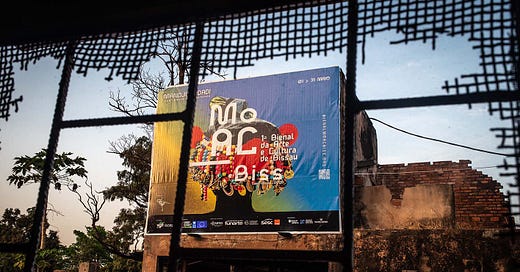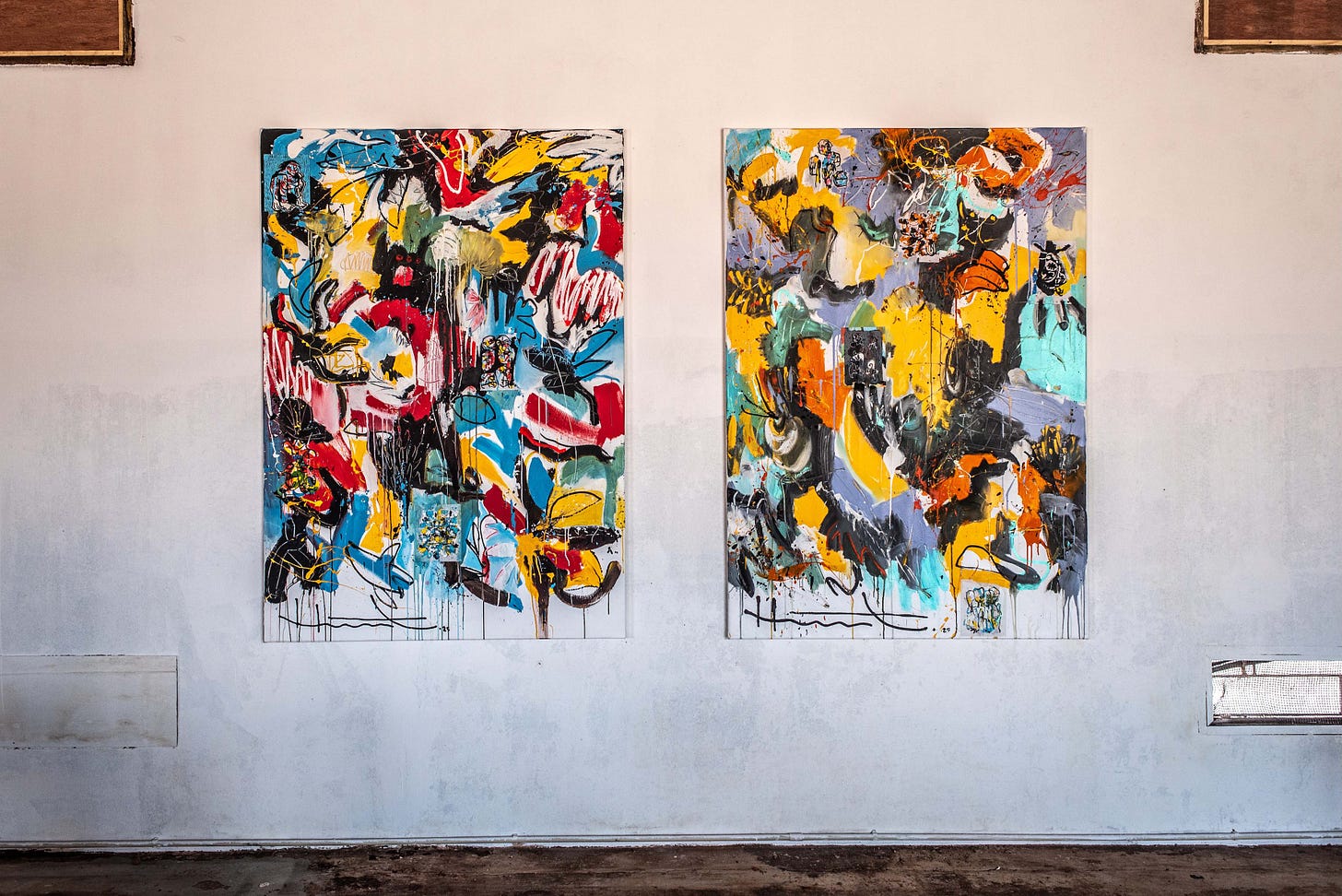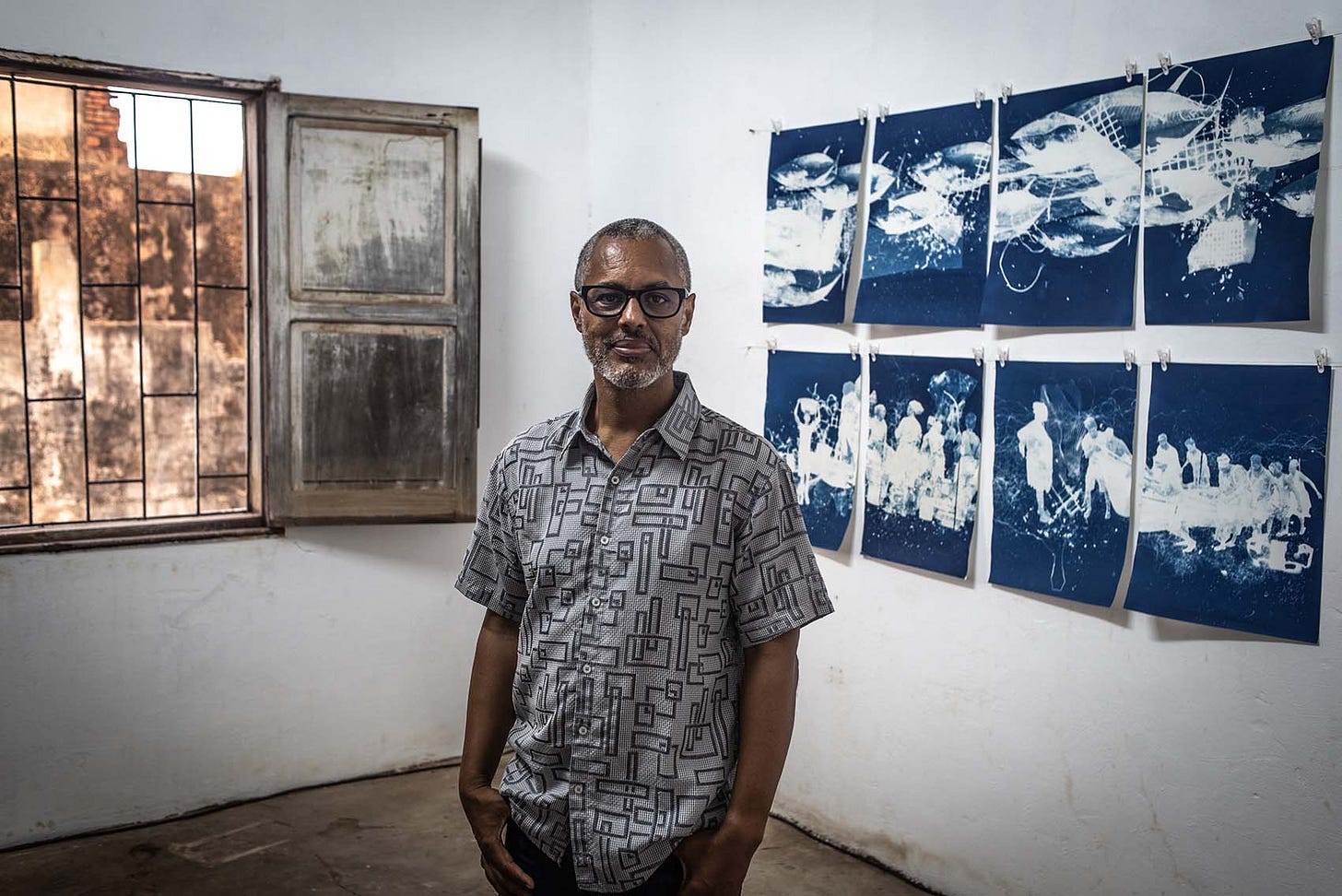Welcome to the Bissau Biennale
‘There is another Guinea-Bissau: cultural, artistic, feeling, thinking, and dreaming of a different tomorrow.’
Jason Patinkin in Bissau
In an old sawmill-turned-art gallery in Guinea-Bissau’s riverside capital, paint-splattered canvases and dreamlike photographs of forests and dancers adorn the walls. Video installations flicker in darkened corners. Dominating the warehouse-like space is Big Kahombo, an installation by Angolan artist Evan Claver. A critique of the promise of migration to the West, it’s a stack of 24 plastic jerry cans painted with a crowd of faces on one side and a smirking woman next to the Statue of Liberty on the other.
In another room, ghostly blue and white images by Cabo Verdean artist Cesar Schofield Cardoso confront overfishing and plastic pollution in West Africa from foreign fishing fleets. Intricate textiles hang loosely from the rafters.
The old sawmill is the main exhibition hall of MoAC Biss, Guinea-Bissau’s new arts and culture biennale which ran through May. The biennale joins a storied West African tradition stretching from the Black Arts festivals in Dakar and Lagos in the 1960s and 70s to today’s massive Dakar Biennale and Burkina Faso’s Fespaco film festival. MoAC Biss will be scheduled for odd-numbered years to avoid overlapping with the well-established Dakar Biennale.
The Bissau Biennale is perhaps West Africa’s most improbable art event. Despite its rich history and culture, Guinea-Bissau has no contemporary art museums, art schools, or specialised art supply shops. Most aspiring Bissau-Guinean artists move abroad or choose other careers.
Though the MoAC Biss debut was much smaller than the region’s other festivals, it brought together dozens of artists and other creatives from across Lusophone Africa, Portugal, Brazil, Guadeloupe, the United States and beyond for near daily gallery openings, concerts, theatre performances, book launches, film screenings, and panel discussions, all free to the public.
The festival drew crowds that regularly exceeded venue capacity. On opening night, concertgoers leapt to their feet as classic Bissau band Furkuntunda reunited after nearly 20 years. Two days later, ushers struggled to contain enthusiastic fans flocking to hear Mozambican singer Selma Uamusse’s rousing set of Afro-rock tunes.
But perhaps no one was as excited about the biennale’s outpouring of creativity as the artists of Guinea-Bissau themselves.
Homecoming and reclamation
“It’s a dream come true. Guinea-Bissau is my home, my ancestors’ home, and I feel so glad to perform here,” said Isabél Zuaa, who was born and raised in Europe to a Bissau-Guinean father and Angolan mother. Zuaa is part of Aurora Negra Collective, a trio of Lusophone African women who staged a standing-room only performance art piece exploring motherhood, femininity, Blackness, and post-colonial identity. Like most artists in MoAC Biss, it was Zuaa’s first time showing in Guinea-Bissau.
Thayra Correia is a Bissau-born and Portugal-based designer of minimalist furniture who features in top festivals across Europe and beyond. She also had never exhibited in Guinea-Bissau until MoAC Biss. “It’s a completely different feeling,” Correia said. “You are home, and you’re making something for home, and with all that, taking into account that home has never had a chance to see it.”
For her biennale collection, Correia embraced the concept of home, eschewing her usual metal and ceramic for indigenous wood and local fabrics. She worked with Bissau-Guinean artisans to build designs that fused traditional forms with her signature sleek style. The resulting artwork earned loud ovations on opening night, vindicating her chosen path. “Being an artist from Guinea-Bissau is an act of hope, it’s an act of resistance,” she said.
Correia hopes that the biennale’s exhibition of Bissau-Guinean and other Black African artists like her proves to aspiring local creatives that “it is possible to be an artist, it is possible to work with art, it is possible to make a life out of it.”
The MoAC Biss idea was born three years ago when a group of Guinea-Bissau intellectuals and artists – many of whom had left their country to pursue careers abroad – met for lunch and shared their frustrations with both their state of the country and its international image.
“Look, it’s bad. The face of a country that has cultural variety, many ethnic groups, much cultural wealth, but is instead known for coups d’état, for corruption, drug trafficking,” said former culture minister Antonio Spencer Embaló, who was at the discussion. They decided to do something to tell a different story about their homeland. “There is another, cultural Guinea-Bissau. There is an artistic Guinea-Bissau. A Guinea-Bissau that feels, that thinks, that dreams of a different tomorrow,” said Embaló who is now on the MoAC Biss organising team.
When they started floating the biennale idea, people told them they were crazy, “because no one goes to Guinea-Bissau,” said acclaimed Paris-based artist Nu Barreto, who curated the visual arts programme. “Yes, no one comes here,” he agreed. “But we have to make things, to create things, that people can come to see. That’s our challenge.”
Building a different tomorrow
In the run up to the festival, the organisers faced all manner of logistical challenges, from insufficient photo printing facilities, electricity shortages affecting video installations, the April blackout in Portugal and Spain which disrupted incoming artists’ flights, and finding the money to run things. Unlike at other biennales which rely heavily on state financing, organisers did not seek funding from the Guinea-Bissau state.
Despite those obstacles, the organisers created something new compared to most West African art festivals which focus on one discipline: visual arts, film, or music.
“Here we have a biennale that marks its identity first and foremost through its multidisciplinary nature,” said Ousseynou Wade, who organised the Dakar Biennale six times. “It has exceeded even my expectations.”
Barreto hopes MoAC Biss will encourage Guinea-Bissau’s government to support future cultural projects. “That’s still our mission to the government, to say to them, ‘okay, come here to see what we’re doing, it’s positive’,” he said. After the biennale wraps, the old sawmill will continue to be a gallery and more buildings will be converted to studio space until the next edition of MoAC Biss.
“Bring the 2027 one,” Correia said. “Because we are gonna be ready.”






